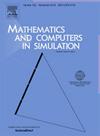A convergence analysis for the approximation to the solution of an age-structured population model with infinite lifespan
IF 4.4
2区 数学
Q1 COMPUTER SCIENCE, INTERDISCIPLINARY APPLICATIONS
引用次数: 0
Abstract
Considering the numerical approximation of the density distribution for an age-structured population model with unbounded lifespan on a compact interval , we prove second order of convergence for a discretization that adaptively selects its truncated age-interval according to the exponential rate of decay with age of the solution of the model. It appears that the adaptive capacity of the length in the truncated age-interval of the discretization to the infinity lifespan is a very convenient approach for a long-time integration of the model to establish the asymptotic behavior of its dynamics numerically. The analysis of convergence uses an appropriate weighted maximum norm with exponential weights to cope with the unbounded age lifespan. We report experiments to exhibit numerically the theoretical results and the asymptotic behavior of the dynamics for an age-structured squirrel population model introduced by Sulsky.
寿命无限的年龄结构人口模型近似解的收敛性分析
考虑到在紧凑区间 [0,T] 上对寿命无限制的年龄结构人口模型的密度分布进行数值近似,我们证明了根据模型解随年龄的指数衰减率自适应选择截断年龄区间的离散化的二阶收敛性。看来,离散化的截断年龄区间长度对无穷大寿命的自适应能力是对模型进行长时间积分的一种非常方便的方法,可以在数值上确定其动态的渐近行为。收敛分析使用了适当的指数加权最大规范,以应对无限制的年龄寿命。我们报告了实验结果,以数值形式展示了 Sulsky 引入的年龄结构松鼠种群模型的理论结果和动力学渐近行为。
本文章由计算机程序翻译,如有差异,请以英文原文为准。
求助全文
约1分钟内获得全文
求助全文
来源期刊

Mathematics and Computers in Simulation
数学-计算机:跨学科应用
CiteScore
8.90
自引率
4.30%
发文量
335
审稿时长
54 days
期刊介绍:
The aim of the journal is to provide an international forum for the dissemination of up-to-date information in the fields of the mathematics and computers, in particular (but not exclusively) as they apply to the dynamics of systems, their simulation and scientific computation in general. Published material ranges from short, concise research papers to more general tutorial articles.
Mathematics and Computers in Simulation, published monthly, is the official organ of IMACS, the International Association for Mathematics and Computers in Simulation (Formerly AICA). This Association, founded in 1955 and legally incorporated in 1956 is a member of FIACC (the Five International Associations Coordinating Committee), together with IFIP, IFAV, IFORS and IMEKO.
Topics covered by the journal include mathematical tools in:
•The foundations of systems modelling
•Numerical analysis and the development of algorithms for simulation
They also include considerations about computer hardware for simulation and about special software and compilers.
The journal also publishes articles concerned with specific applications of modelling and simulation in science and engineering, with relevant applied mathematics, the general philosophy of systems simulation, and their impact on disciplinary and interdisciplinary research.
The journal includes a Book Review section -- and a "News on IMACS" section that contains a Calendar of future Conferences/Events and other information about the Association.
 求助内容:
求助内容: 应助结果提醒方式:
应助结果提醒方式:


